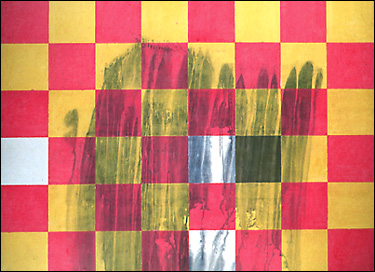
Castro Leñero’s Amarillo y rojo (Yellow and Red) unites seemingly opposing traditions of abstraction. The pink and yellow grid refers to geometric abstraction, while the stain that covers a large portion of the surface recalls gestural abstraction. The rationality of the grid tries to impose order on the composition, while the stain disrupts that logic.
Amarillo y rojo, 1993. Francisco Castro Leñero (Mexican). Acrylic on canvas: 74" x 102". Purchased with Ewing Halsell Contemporary Latin American Art Acquisition Fund.
Castro Leñero works in the tradition of abstract art in which pure form, rather than figurative subject matter, relates both feeling and meaning. His work is often characterized by geometric shapes rendered with a subtle roughness. The brown, grey, and black tones of many of his works have been compared by some critics to the sandy texture of cave walls, reminiscent of the homes of early humans. He works in both large and small format, exploring the effects of size.
In his own words: “I paint because I feel that art represents an essentially human activity. Man’s testimony for his fellow men. Within a reality where it is difficult to identify ourselves, art makes us conscious of such self-identity and confronts us with it.”